I rented a flexible fuel vehicle on a trip recently. It was a Dodge Journey that I had selected mostly because it was the biggest vehicle on National’s Executive Aisle at the time. And bigger is frankly much better when I’m traveling with my wife and three kids. I didn’t notice that it was a flex-fuel vehicle, much less that it was a brand new flex-fuel vehicle, until we were just off the lot and the odometer rolled from 3 to 4 miles. I just don’t pay that much attention to such things I guess.
The rental was fine and we did enjoy the new car smell for a change.
As we were driving back to the Detroit Airport to return the car, I grumbled to my wife that I had forgotten to fill it up a few exits back. I knew from experience – my wife’s family is from Michigan so we get back there a lot — that the station nearest the car rental return (a BP) is always like a buck higher than anywhere else. It’s irritating. Using Waze, she quickly determined that there was a Speedway just around the corner where gas was $2.99 instead of $3.79 per gallon. We had a few extra minutes, so we headed over there instead.
As we pulled in, I noticed that E-85 was only $2.19. The lightbulb in my head slowly turned on as I remembered that I was driving a flex-fuel vehicle.
I’ve had experiences with putting the wrong fuel in a rental car before (not me, don’t judge) so I asked my wife to get out and check that I wasn’t about to do something stupid. She rolled her eyes but walked around to confirm that I wasn’t colorblind and that the cap did indeed say E-85 / gasoline, so presumably I was safe to proceed.
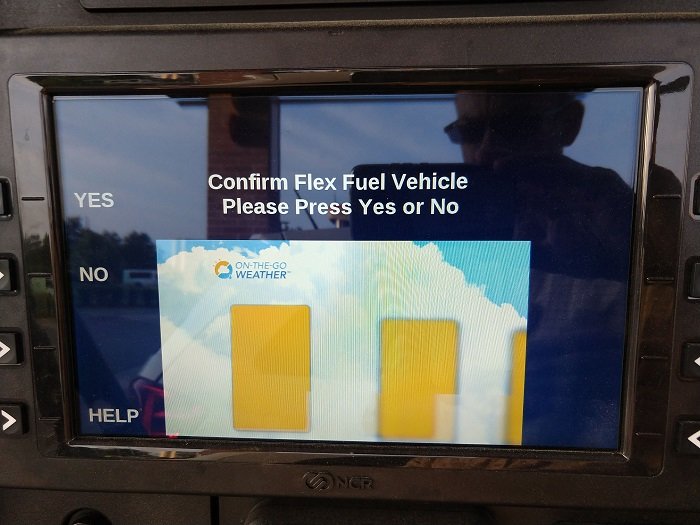
Are you sure you’re driving a flex-fuel vehicle?
The car ended up taking 12.8 gallons of E-85 at a cost of $28.02. Had I filled up at the same station with gas it would have cost me $38.27, or if I had blindly driven into the BP it would have been a whopping $48.51.
I left feeling I had pulled a fast one, having saved either $10 (or $20) depending on how you look at it.
What is a flex fuel vehicle?
A flexible fuel or dual-fuel vehicle is an alternative fuel vehicle that is designed to run on more than one fuel, typically gasoline blended with either ethanol or methanol. The key is that the fuels are stored in a common tank, and the engine is designed to operate on any combination of them. So you always have the choice as to what to put in the tank.
E-85 is a bio-fuel blend of about 85% ethanol and gasoline. Ethanol is primarily derived from corn, which is of course a major crop in the Midwest. Without going into technical details, the energy density of ethanol is lower than gasoline, meaning there is less energy (and thus fewer “miles”) in each gallon of the fuel. I’ll note that the fuel is heavily subsidized, and also controversial because it diverts land toward growing fuel instead of food. But those topics are mostly outside the scope of this discussion.
In the US, flex-fuel vehicles have a distinctive yellow “gas” cap that is labeled E85 / gasoline to remind you that you can choose what fuel to put in the tank. They often also have a logo on the back near the make or model so that other drivers will know you drive a “green” car.
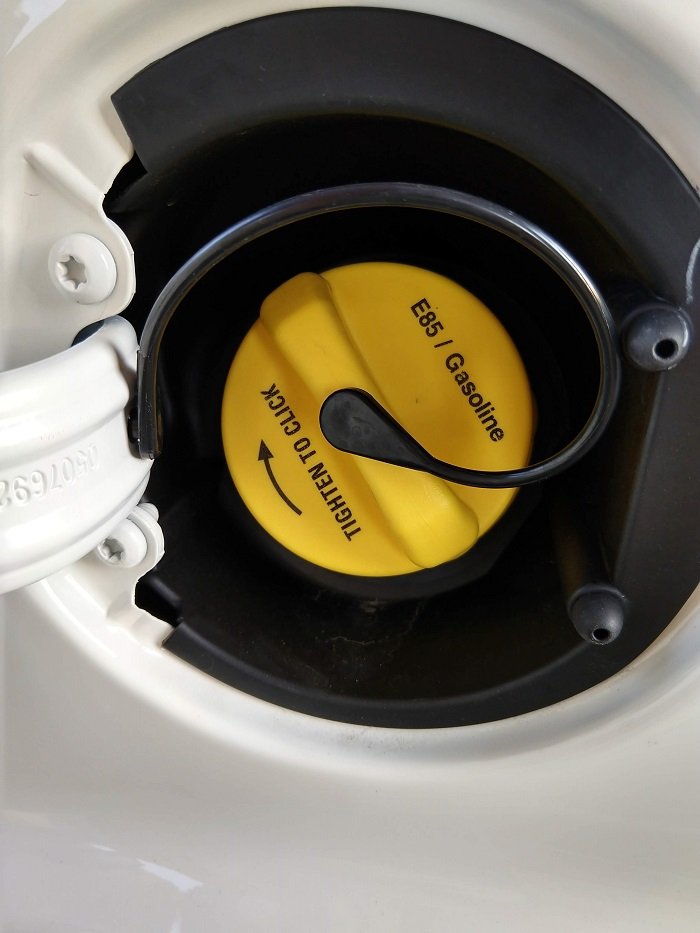
Flex-fuel vehicles in the US have a distinctive yellow gas cap
Should you rent a flex fuel vehicle when traveling?
I’ve worked in renewable energy for nearly a decade, but my experience with biofuels is limited. Still, I sort of know the arguments on both sides. So I started doing the math.
I obviously saved $10 at the pump compared to what I could have paid, but did I really save overall? The problem is that biofuels don’t have the same energy density as gasoline. This basically means you are getting fewer miles per gallon when you burn them in your engine.
A common estimate is that you’ll get 28% worse fuel mileage with E-85 than with gas, so E-85 needs to be at least 28% cheaper than gas for you to break even. In my case, E-85 was 27% cheaper than gas. That means that if this were my personal car, refueling with E-85 would roughly be a wash since I’d pay less for a tank of it, but I’d also go proportionally less far.
But of course, this isn’t my car.
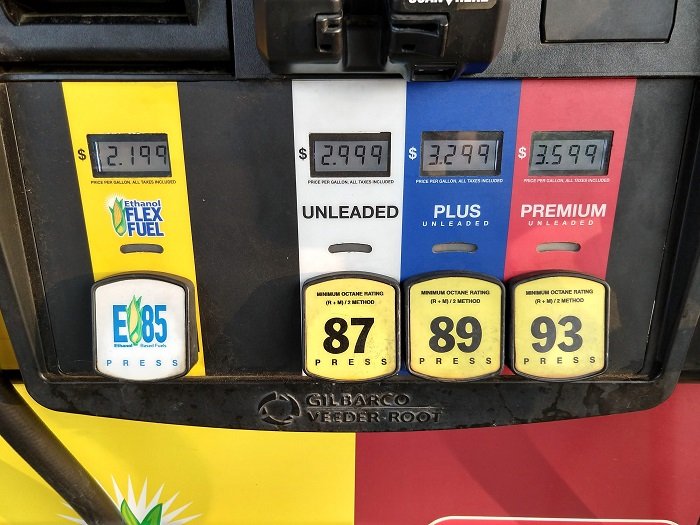
E-85 is usually significantly cheaper than gasoline
I was minutes away from returning the vehicle when I refueled it, so the lower gas mileage from this fill-up was going to impact the next guy, not me. Whether I got screwed or not was thus dependent on what the previous renter had put in the tank. And of course, there’s no way to know that until you actually drive it and see what your fuel mileage looks like.
In my case, the car was literally brand new, so what had National filled it with? (I’m assuming that vehicles are delivered from the factory with a nearly empty tank, though I could be wrong.)
We had driven 283 mostly highway miles on our trip, so I calculated that I had gotten 22.1 miles per gallon. The website fueleconomy.gov indicates that a Dodge Journey should get 17 mpg (city) / 25 mpg (highway) when fueled on gas, and 12 / 18 mpg on E-85. Based on that, I’d have to conclude that it was gas in the tank at the time we picked it up. And therefore, I essentially traded 12.8 gallons of gas for 12.8 gallons of E-85, which is a good deal for me. Of course, the next guy might not agree….
And therein lies the rub.
Whether renting a flex-fuel vehicle is a good deal or not depends largely on what was in the tank at the time you picked it up. If you get a tank of gas, the numbers are probably going to work out in your favor. But if you get a tank of E-85, it’ll be a wash at best. And in the worst case, you could get a tank of E-85 and then end up returning it with gas. That would mean that you’d basically be out that $10 or more.
Can you predict whether there’s E-85 in the tank?
Unfortunately, there’s no way to know whether there is E-85 or gas in the tank when you pick up the rental car. But if the nearest station to the airport (or next-nearest station in my case) sells E-85, I would conservatively assume that that’s what’s in it. I mean, I’m sure I’m not the only one who likes to save a buck!
If the airport, or city, doesn’t have many E-85 stations, or you’re in an area where people are perhaps a little less sophisticated, then maybe the odds of getting a gassed-up car are better.
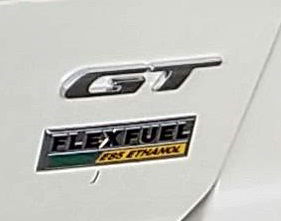
If you see this logo on the car, there’s a good chance there’s E-85 inside
Where can I buy E-85?
According to the 2012 census data, there were about 115,000 gas stations in the US. And there are currently about 3,500 stations that sell E-85. So your odds of randomly pulling into a station and finding E-85 (like me!) are actually pretty poor.
The odds are a bit better, however, if you are in the Midwest — also known as the corn belt — where the majority of the stations selling E-85 are located.
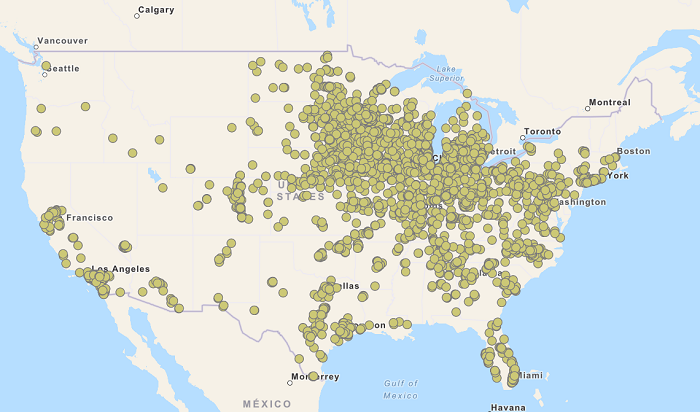
Filling stations selling E-85 in the United States (courtesy of the AFDC)
If you’re the the planning type, it’s best to scout out potential E-85 refilling stations ahead of time. The US Department of Energy’s Alternative Fuels Data Center (AFDC) has developed an app and website that will show you the nearest stations selling E-85 to where you’re going to be. Or you can have it show you stations along a route. It’s pretty slick. (Disclaimer: I know the guys at the National Renewable Energy Laboratory that developed it.)
Here are the results from searching for E-85 stations around the Detroit Metro Airport.
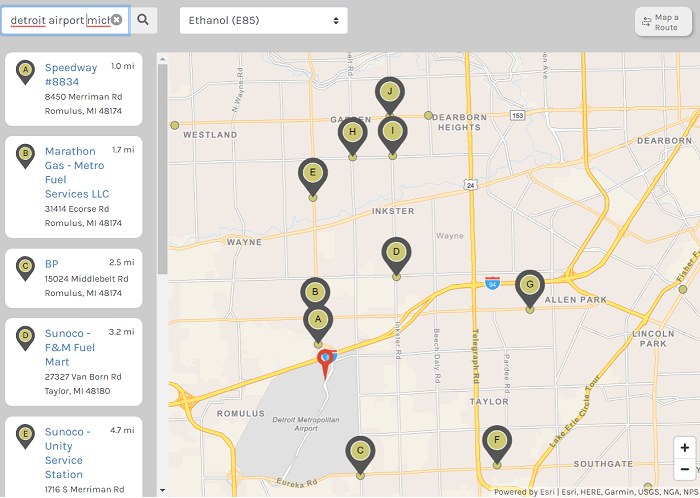
Stations selling E-85 near the Detroit Metro Airport (courtesy of the AFDC)
My flex-fuel rental strategy going forward
I’m convinced that if I know I can return a flex-fuel rental car full of E-85, then I should probably rent one. If I get lucky, it might be full of gas when I pick it up – like it was this time – and then I have the chance to return it full of E-85, which puts about $10-$20 in my pocket. In the worst case, it will already be full of E-85, and I’ll return it with E-85. In that case, it’ll just be a wash.
But for cases where I’m not sure whether I can find a station selling E-85 near the airport, I’ll avoid flex-fuel vehicles. I don’t want to burn a tank of E-85, get lower fuel mileage, and then end up returning it with gasoline. I’m the type who gets irritated at stuff like that, so I’d just rather avoid it. And of course, most of the time, I won’t know for sure that I can easily fill it with E-85.
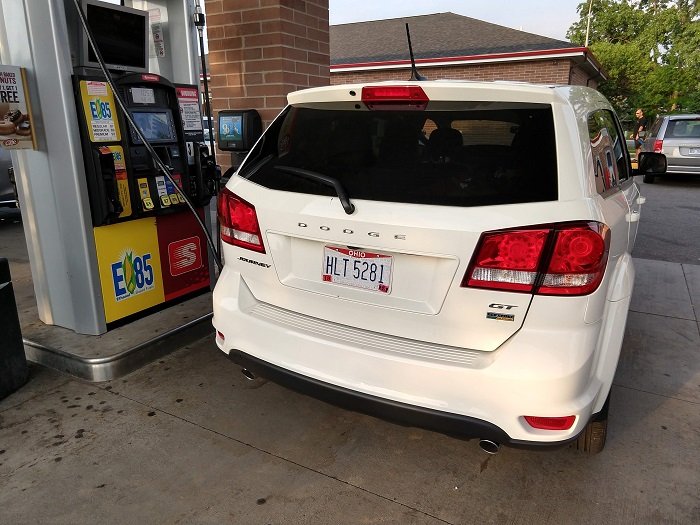
Refueling our Dodge Journey with E-85 near the Detroit Airport
Bottom line
My primary consideration for rental car vehicles when I’m traveling with my family is always going to be size. But now that I know there is a station near the Detroit Airport that sells E-85, I will keep an eye out for flex-fuel vehicles when I’m there. As long as I know I can refuel them with E-85, I figure renting one is a bit like buying a lottery ticket. I might get lucky and win $10 or $20, or at worst, I probably won’t lose anything.
But for airports I’m not so familiar with — which is most of them — I think I’ll pass. I have enough to worry about.
Do you rent flex-fuel vehicles when available?





If you’re planning a long trip, don’t forget that lower fuel economy of E85 also means more stops to refill, because you’ll get less miles per tank, too.
I own a e85 car. I fill the tank with e85 every other fill. I also never let my car get much below a 1/2 a tank. By doing this I get close to the same miles per gallon that I would running gas only.
I know this sounds incredibly simple, but it is. Want to know if you have E85 in the tank? When running the car, does is smell like a bar? If yes, it is E85. It really is that simple. I have an E85 truck and use it all the time and my garage smells like a bar when I do.
The problem with rental cars is that even though the fuel gauge says FULL most cars can drive about 50-60 miles on a new tank before the needle gets off the FULL reading.
So I always find that the last person who filled the car did not fill it completely and thus the first tank gets "really poor mileage" because the tank is not full.
I was surprised to read above that the loss of...
The problem with rental cars is that even though the fuel gauge says FULL most cars can drive about 50-60 miles on a new tank before the needle gets off the FULL reading.
So I always find that the last person who filled the car did not fill it completely and thus the first tank gets "really poor mileage" because the tank is not full.
I was surprised to read above that the loss of efficiency was as high as 27% but did check it in the literature. The producers suggest that the loss is probably in the range of 15% to 27% depending on the actual ethanol content of the fuel which could be as low as 51% and still be called E85. This low level would result in a lower loss (15%).
DKB Come to Venezuela.. way less 1 cent a GALLON at this moment.
Guns are totally banned too (a Liberal Paradise down here!) which makes it the saf... err, sorry, it is currently the most dangerous country in the world.
But cheap AF without a doubt.
DKB, go to Egypt instead, $1 per gallon.
$6.73 per gallon in Ireland at the minute, you do have crazily cheap prices in the US
As a Midwesterner and one whose families grow corn, we appreciate you using E-85. E-85 is suppose to promote energy independence to reduce our need to import oil (even though the USA is starting to become a net oil exporter thanks to fracking and the oil fields in North Dakota). It's suppose to reduce our dependence on fossil fuels (which it does... somewhat). And finally, the cost for E-85 is subsided in part through the...
As a Midwesterner and one whose families grow corn, we appreciate you using E-85. E-85 is suppose to promote energy independence to reduce our need to import oil (even though the USA is starting to become a net oil exporter thanks to fracking and the oil fields in North Dakota). It's suppose to reduce our dependence on fossil fuels (which it does... somewhat). And finally, the cost for E-85 is subsided in part through the generosity of the US Government (that means you, fellow taxpayers). So you through your taxes pay for E-85 anyway. If there was no subsidy, E-85 costs a heck of a lot more than regular.
In Brazil, they have used biofuels for years very successfully. Cars are developed there to run on E-100 (100% Ethanol). Pollution has dropped, and their dependence on fossil fuels had lessened.
So is it worth it to use E-85? If you can save money in your rental, go for it! If you are into reducing your dependence on depleting stocks of fossil fuels, thanks for your support! If the car you are driving doesn't support E-85, don't do it. Don't be an idiot and fill up with fuel you know will damage the car. Karma will pay you back big time.
As for me driving in the Midwest, if it's my personal car, I never use E-85 (yea, my cousins may complain, but heck, they can grow soybeans for bio-diesel or jet fuel if they want). It reduces car performance and can increase car maintenance. That and I really hate the subsidies that E-85 gets. So if nobody uses E-85, the Government will stop giving out welfare to the farmers, and maybe my taxes will drop (wishful thinking).
Based on your extensive calculations I think I've come to the conclusion that the search time to identify E85 vehicles in inventory at my car rental facility, whether very near stations offer E85, and whether any stations along my intended route offer E85, whether said E85 stations are in fact close enough to the airport that I can return the vehicle "full" after filling there, the additional planning to make sure I happen to hit...
Based on your extensive calculations I think I've come to the conclusion that the search time to identify E85 vehicles in inventory at my car rental facility, whether very near stations offer E85, and whether any stations along my intended route offer E85, whether said E85 stations are in fact close enough to the airport that I can return the vehicle "full" after filling there, the additional planning to make sure I happen to hit said E85 station along with the probability I can pull it all off simply isn't worth the possibility of $10.
One trick that takes less time and probably can save that much is just watch your odometer and fuel gauge when you start and figure out how many miles you can drive before your fuel gauge no longer reads full to figure out how many gallons you've used. Often it's 3-4 gallons worth. Then don't fill your tank up all the way when you're returning your vehicle based on that (and how far you are from the airport).
Otherwise I like @warreng24's advice to always fill any car with E85. Just play dumb if anyone calls you on it.
The top post is about to make a costly mistake. E85 means ethanol 85%. It does NOT mean 85 octane. In other words, you're not putting 85 octane gas, which might be passable. You would be putting 85% ethanol in a car made for 10% ethanol maximum. If the car's engine has trouble, you could be in for a big repair bill.
I personally don't think it's ethical to try to separate the macroeconomic and ecological aspects of the E85 programme from the personal. Biofuel from corn is ecologically irresponsible and drives up the cost of food, particularly in poorer countries. I just can't justify a tender in my pocket against that.
Debit,
This kills me -- it really does -- but you win Best Post of the Day.
Corporate finance evidently does translate into everyday life.
While I see your point, the "stick it to the next guy" philosophy seems harsh. To each their own, I guess.
Allen,
Wrong. You can't change point of reference from one calculation to next.
It should be .28/1 Not .28/.72
I believe your math is off. If you're getting 28% less mileage per gallon of gas, you need the E85 gas to be 39% cheaper for a wash.
It's not worth wasting your time thinking about it.
I’ve been doing this for years. One thing worth noting is that the vast majority of renters don’t know what e-85 is, where they can get it, or even that their rental can use it, so I’d guess your odds of happening on a vehicle filled with e-85 are pretty low.
Enjoyed this article. For the longest time I assumed FlexFuel was the US car brand’s version of the Eco car decal. Guam doesn’t sell E-85 gas so had no idea it existed.
Its a rental car, and they'll never know. So, even if it isn't a flexfuel car, I'm putting in the cheapest fuel available. Even if its E85.